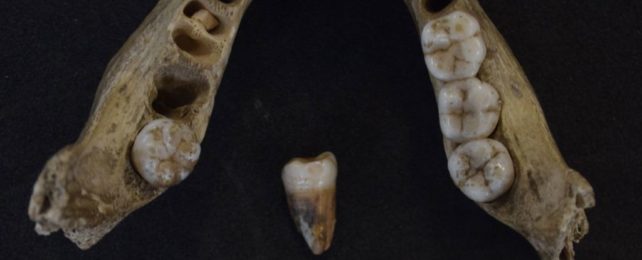Around 27,000 years ago, an immense sheet of ice coated two-thirds of the British Isles, making the region less than hospitable for human habitation.
That all changed as the warming climate transformed the landscape, inviting communities to find a new home on its fertile soils. Archeologists are piecing together the stories of those early migrants, finding the region became a veritable melting pot of culture.
The oldest human genomes from remains uncovered in either Britain or Ireland point to at least two different origin stories, each threading their way back to the European mainland and beyond.
One fossilized individual from Gough's Cave in Somerset has a genome that can be more closely linked with ancestors found at sites in Spain and Belgium.
Another from Kendrick's Cave in Wales has genetic links to ancestors represented at sites in Italy.
Radiocarbon dating suggests both humans were alive in Britain more than 13,500 years ago, just a few thousand years after the region's immense sheet of ice retreated towards the Arctic.
The bones from Gough's Cave are the oldest of the two remains. They died around 15,000 years ago, which means their ancestors probably joined a wave of migration from northwest Europe at least a thousand years before their lifetime.
The individual from Kendrick's Cave lived a few thousand years after that, and their ancestors probably migrated from the Near East into Britain around 14,000 years ago.
"Finding the two ancestries so close in time in Britain, only a millennium or so apart, is adding to the emerging picture of Paleolithic Europe, which is one of a changing and dynamic population," says evolutionary anthropologist Mateja Hajdinjak from the Francis Crick Institute in the United Kingdom.
By about 16,000 years ago, the British-Irish ice sheet had virtually disappeared. Fossils from this time are scarce, and other human remains that have been found only date back to about 15,500 years ago, a few centuries before Britain's climate began to warm rapidly.
Who these people were and where they came from are still open questions.
In 2018, archaeologists revealed that a human fossil also found in Gough's cave dated back to about 10,500 years ago. Known as the 'Cheddar Man', this fossil was, at the time, the oldest human in England to have their whole genome sequenced.
The findings suggest the ancient man had dark skin and blue eyes, a sign that the population was yet to adapt to the higher, colder latitudes. The Cheddar Man's ancestry was a mix of western European hunter-gatherers and members of an earlier migration to England.
Many of the same researchers involved in earlier investigations are involved in this latest analysis, hoping to see what other ancestral connections can be found.
"We really wanted to find out more about who these early populations in Britain might have been," says biologist Selina Brace from England's Natural History Museum, who worked on both papers.
"We knew from our previous work, including the study of Cheddar Man, that western hunter-gatherers were in Britain by around 10,500 years BP, but we didn't know when they first arrived in Britain, and whether this was the only population that was present."
The new results suggest post-glacial settlers in Britain were not only genetically distinct. They also appear to be culturally distinct.
The burial practices in the Gough Cave and Kendrick's Cave were noticeably different, as were their diets. The Gough Cave shows signs of both animal and human bones. A human skull was even found shaped like a cup, possibly for cannibalistic purposes.
The human from Kendrick's Cave, meanwhile, shows chemical traces in their bones of having eaten marine and freshwater fish and mammals. Unlike Gough's Cave, however, there are no signs of deer, aurochs, or horses that had been eaten by humans.
"Combined, these lines of evidence support the interpretation that at least two different human groups, with different genetic affinities and dietary and cultural behaviors, were present in Britain during the Late Glacial," the authors write.
One lineage is connected to ancestors found at sites in Villabruna, Italy, while the other appears to be a combination of Goyet ancestry related to those from sites in Belgium and El Mirón ancestry from Spain.
The Cheddar Man, according to some models, could be a mix of all three ancestries.
"This presents a picture of a dynamic and varied Late Glacial period within Britain, with changes occurring in the Late Upper Palaeolithic in diet, funerary behaviors, technologies, and genetic affinity at a time of rapid environmental and ecological change," the authors conclude.
"With the addition of our data to the existing knowledge of early prehistoric genetics in Britain, the emerging scenario is one of multiple genetic population turnover events in the United Kingdom."
The study was published in the Nature Ecology & Evolution.
